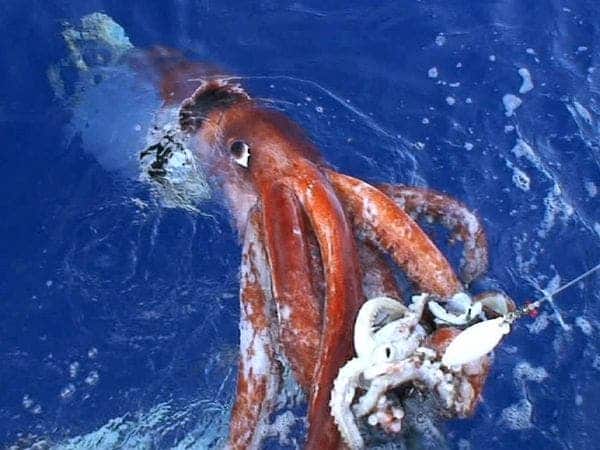Spanish researchers are shining a (robotic) light on the lives of one of the most mysterious animals on Earth: the elusive giant squid.

Giant squids are a near-mythical animal. For the longest time, it wasn’t even clear if they really existed, or if they were simply a retelling of the story of the leviathan. Sightings in the last few decades have confirmed that they do exist, but many unknowns remain around these multi-limbed beasts.
Robots are allowing us to peer at the depths that harbor giant squids in order to see how they behave in their natural habitat. One of the first videos showcasing this animal hunting in the wild was unveiled only as recently as 2021. But although they let us reach much deeper depths than ever before, our current robots are ill-suited to the study of giant squid.
One team led by Nathan Robinson of the Oceanographic Foundation in Spain is working on a solution to this limitation.
Lying in wait
For starters, the bright lamps seafaring robots use to light their surroundings are uncomfortable for the eyes of giant squid — these sensitive, low-light eyes can grow as large as dinner plates. These machines also produce strong sounds and vibrations that are especially jarring in the depths of the ocean. These factors can easily scare off mobile underwater wildlife, including the fearsome giant squid, or at least alter their natural behavior.
Naturally, bringing the animal up to the surface would make it completely impossible to record its behavior in its natural environment.That’s why a team of researchers led by Nathan Robinson of the Oceanographic Foundation in Spain devised a different solution: a passive deep-sea platform, equipped with a camera. Because giant squid eyes are optimized to see shorter-wavelength blue light, they used longer-wavelength red lighting that won’t bother them, in order to see the animals on video.
That’s why a team of researchers led by Nathan Robinson of the Oceanographic Foundation in Spain devised a different solution: a passive deep-sea platform, equipped with a camera. Because giant squid eyes are optimized to see shorter-wavelength blue light, they used longer-wavelength red lighting that won’t annoy them, in order to see the animals on video.
The final thing needed was suitable bait; the team went for a fake jellyfish, called E-jelly. E-jelly comes equipped with internal lights that mimic the blue bioluminescence emitted by an atolla jellyfish (Atolla wyvillei) in distress. Giant squid aren’t known to hunt this species in particular, but the team hoped that the distress lights would attract the beast. After all, if a jellyfish is under attack, something must be attacking it — and the squid might like to eat that something.
After the rig was constructed, the team submerged and tested it at depths between 557 and 950 meters (1,827 and 3,117 feet) in the Gulf of Mexico and in the Exuma Sound near the Bahamas. There, it recorded several giant squid lured by E-jelly.
Two of these sightings took place in 2004 and 2005 with what may possibly have been Promachoteuthis sloani. This species was previously only known from small juveniles, but the individuals caught on video were much larger, with mantle lengths in excess of one meter (3 ft) — mantle lengths denote the length of the squid’s body without the tentacles.
The next few encounters involved Pholidoteuthis adami, squid whose mantle lengths reached around 0.5 meters, in 2013. Finally, in 2019, the team filmed Architeuthis dux, the giant squid, clocking in at a mantle length of 1.7 meters
The experiments suggest that the squid are in fact visual hunters, as they tended to ignore olfactory (smell-based) bait and went straight for visual bait. The encounters also gave researchers a better understanding of the distribution of each species of large squid and their preferred hunting methods.
In general, each squid trailed the platform for around six minutes before launching an attack, suggesting that they like to stalk prey before engaging. This goes against previous assumptions that giant squid are primarily ambush predators.
“We recommend that future studies assess the value of using low-light systems or optical lures in a more scientifically-robust manner,” the team concludes in the paper detailing these encounters, published last year. “For example, while the bioluminescence-mimicking E-Jelly appears to be an effective tool for attracting cephalopod species, future studies could assess whether lures of differing intensities, colors, or light patterns vary in their capacity to attract various taxa of deep-sea cephalopods.”
The paper “Studying the swift, smart, and shy: Unobtrusive camera-platforms for observing large deep-sea squid” has been published in the journal Deep Sea Research Part I: Oceanographic Research Papers.






